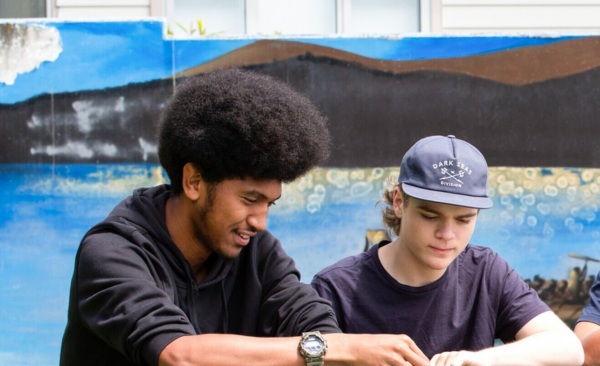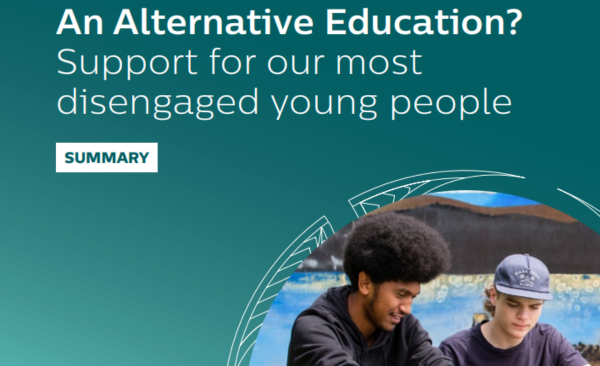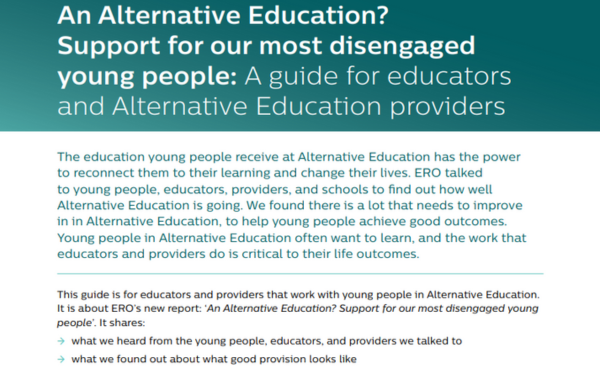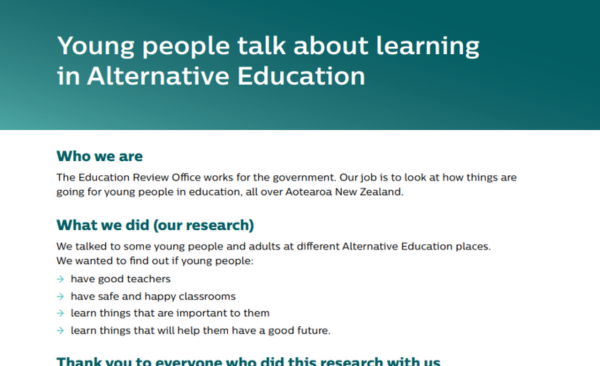Young people in Alternative Education are among the most disengaged from school. Quality education can change that. The education young people receive at Alternative Education has the power to reconnect them to their learning and change their lives. ERO talked to young people, educators, providers, and schools to find out how well Alternative Education is going. Young people in Alternative Education want to learn, and you can help with their learning.
This guide is for school leaders who have, or are considering referring learners to Alternative Education. It is about ERO’s new report: ‘An Alternative Education? Support for our most disengaged young people’. It:
- shares what we know works in Alternative Education
- describes how you can support learners in Alternative Education
- gives ‘big picture’ findings about how well everyone is working together to help these young people learn, and where improvements could be made
- shares what our recommendations are for overall improvement.
What is Alternative Education?
Alternative Education is one of the options available to you when supporting your most disengaged learners. It is an educational intervention provided to young people who are disengaged or alienated from school and who are unlikely to be able to learn productively in school.
Alternative Education aims to provide young people with a quality education and support them back into education, training, or work.
What did we find out about Alternative Education?
ERO’s evaluation had ten key findings:
- Young people in Alternative Education are the most highly disengaged from education.
- Young people in Alternative Education are disproportionately Māori and male. Though providers reports the number of females has increased recently.
- Young people are referred to Alternative Education due to behaviour. . Over a quarter have been suspended or excluded. They are also referred due to attendance issues, and alienation from school. Sometimes they are referred by Youth Justice or Oranga Tamariki.
- These young people’s needs have not been identified and met early enough. They also have significant gaps in their learning, which have not been addressed. Waiting for a place at Alternative Education deepens the disengagement. This indicates that our education system is not currently set up with sufficient, or the right range of, provision to meet the needs of these young people.
- While in Alternative Education these young people attend more, enjoy learning more, and feel safer. They have a stronger sense of belonging and improved behaviour.
- When they move out of Alternative Education only around one in four return to school. More than half do not go on to further training or employment. By age 20, almost 70 percent are receiving benefits.
- Alternative Education does not provide good outcomes. These young people have significantly worse outcomes than other young people, worse even than very similarly disengaged young people with high needs. They are very unlikely to achieve an education qualification. As adults they are much more likely to be receiving benefits and be involved in the criminal justice system.
- The current model of Alternative Education is inadequate to meet the level of need of these often highly disengaged young people, leading to worse outcomes than for other young people.
- Teaching is weak and teaching resources are inadequate.
- Facilities are often so run down they act as a barrier to learning.
- Funding is inadequate.
- Funding limitations make it unviable for many providers and providers and staff turnover is high.
- Providers are often isolated from other providers and schools, so they often lack access to broader education resources (e.g., careers advice, specialist subjects, sports) and professional teaching support.
- Providers cannot access the broader wrap-around support young people need.
- Accountability for delivery and outcomes is weak.
- When young people (exceptionally) do succeed at Alternative Education it is due to the elements of the model that do work:
- small class sizes
- having the same educator throughout the day
- the flexibility to provide a different education on a site separate from school
- having staff with experience, aptitude, and commitment to working with these young people, who act as positive role models.
- Alternative Education is potentially a missed opportunity to change these young people’s life trajectories. They are often engaged and attending but the current model of provision is failing to provide them with a quality education and may be contributing to poorer outcomes. The long term costs for the young person, their family, and broader society, are very significant.
What can you do to help learners who are disengaging?
The best thing you can do to help disengaged young people succeed is to work with them and their whānau to help them re-engage in learning and stay in school. Learners attending Alternative Education have an increased risk of poor outcomes later in life.
Learners at risk of disengaging often have a pattern of low attendance, suspensions, and transience. You can support young people at risk of disengaging through:
- school-based individual learning or behaviour plans to help engagement in learning
- teachers or leaders work with their parents and whānau to support young people’s attendance and engagement in school
- getting Resource Teacher: Learning and Behaviour (RTLB) support to meet their learning and behaviour needs
- accessing to the Ministry of Education’s learning support and behaviour specialists.
Before referring a young person to Alternative Education:
You need to follow the Ministry of Education Alternative Education guidelines, and ensure that the young person and their whānau agree Alternative Education is the best choice for them. You can also:
- make sure the Alternative Education programme is suitable for the young person’s needs and interests
- work with the young person, their family and the provider to make sure they have a clear pathway back to education
- pass on to the provider all relevant information about the young person to ensure their needs (learning, health and wellbeing) can be met in Alternative Education
- monitor young people’s achievement and provide access to extracurricular activities and curriculum support
- where possible, have an open door, so the young person can be included at school.
Five areas for action
Area 1: Better identify and meet the needs of these young people before they become disengaged, and increase the number who are able to stay and succeed in mainstream schooling.
- providing guidance on how to effectively identify young people most at risk of disengagement
- supporting schools to act early to help young people stay in school
- sharing with schools best practice in managing challenging behaviours.
Area 2: Make sure there are a range of effective options (of different type, intensity, and duration) available for those young people who are not thriving in the school setting, and that there are clear, consistent, and rigorous gateways so that young people are matched to provision that best meets their needs.
- examining the range of options available for those young people who are not thriving in the school setting
- developing guidance around accessibility of options, good transitions, and the role of agencies for each option.
Area 3: As part of this set of options, reform the ‘Alternative Education’ model of provision so that there is a new model that is designed to meet both the education and broader needs of the most disengaged young people who need an alternative to mainstream schooling.
- developing a clear national model and set of standards for high quality ‘Alternative Education’ provision, including better funding, requiring registered and quality teachers, and better access to recourses to support learning
- ensuring all current and future 'Alternative Education’ provision has suitable premises and facilities
- supporting teachers in ‘Alternative Education’ with a lead of professional practice, curriculum resources tailored for young people in ‘Alternative Education’, and facilitated professional networks
- agencies work together to ensure young people in ‘Alternative Education’ are a priority for the specialist support they need.
Area 4: Put in place the support needed for successful pathways and transitions from ‘Alternative Education’ into further education, training, or employment.
- agencies review the transition and ongoing support for young people in ‘Alternative Education’.
Area 5: Strengthen accountability and monitor how well provision is meeting the needs of young people who are in ‘Alternative Education’.
- actively monitoring the quality of provision in ‘Alternative Education’
- reporting annually on the education experiences and outcomes for young people in ‘Alternative Education’, including wait times
- ensuring ‘Alternative Education’ providers and contract-holding schools collect and report reliable data on young people’s enrolment, education outcomes and destinations.
Where can schools go to for help?
Ka Hikitia – Ka Hāpaitia – Education in New Zealand – the Māori Education Strategy, aimed at supporting Māori young people to achieve excellent and equitable outcomes
He Pikorua in action – Ministry of Education information on guiding practices within the Learning Support Delivery Model
Supporting Children in Care – Education in New Zealand – Ministry of Education guidance for educators working with young people who are, or have been in care
If you want to find out more about our evaluation on learning in Alternative Education, you can read our ‘An Alternative Education? Support for our most disengaged young people’ report or summary.




